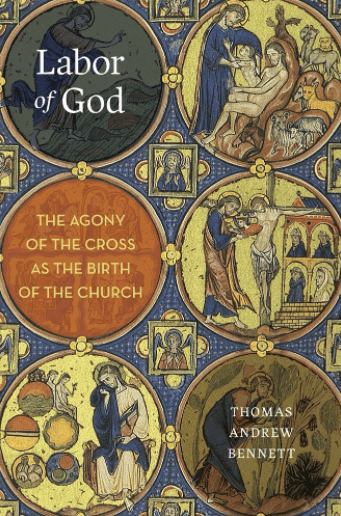What happened at the cross and after it the resurrection? Metaphors are applied time and time again. At first they blow fresh air on atonement theology and then they wear out. New ones come and go; old ones appear and then fade.
 Thomas Andrew Bennett, in his new Labor of God, contends the old metaphors revolving around sacrifice and substitution have faded from potency and we need fresh air: his proposal is “labor of God” as a fresh angle on atonement, air that will breathe new life onto the history of metaphors.
Thomas Andrew Bennett, in his new Labor of God, contends the old metaphors revolving around sacrifice and substitution have faded from potency and we need fresh air: his proposal is “labor of God” as a fresh angle on atonement, air that will breathe new life onto the history of metaphors.
He contends we need to pay attention to lexical adaptation, to metaphoric disclosure, to irreducible metaphoric meaning, and to ground it all in Scripture. (I’d begin with that, but I can’t see it impacts what Bennett says in this book.)
Have we ever considered what happens to our faith when one metaphor begins to rule all other metaphors? When this happens everything in theology — our view of God, our view of Christ, our view of ourselves, our view of the world, our view of the church, our view of the future — collapses under the weight of one metaphor?
I contend this has happened with propitiation, which is a kind of substitutionary atonement but not the whole of it (in spite of strident voices to the contrary). To be a substitute is not the same as being the object of wrath, though the latter is a species of the former. The issue is not which is right but what happens when one metaphor rules: God becomes too much the God of wrath, Christ becomes the object of God’s wrath, we become the escaped objects of wrath, the world is under the wrath of God, the church is for those who have escaped the wrath, and the future becomes the place where wrath is finally over. Of course, that’s simplistic but let’s not doubt such simplicity opens a window onto some theological realities.
Bennett says there’s a better way:
Rather than repeating the language of sacrifice or victory or ransom or influence, pastoral theology would do better to complicate it, bedim it [as in “dim,” being diminished], point out its inconsistencies, and recapture its mysteries.
Why metaphors? Because atonement is too big to reduce:
The complete ontological status of atonement, which is to say “whatever happens between God and humanity in and through the career of Jesus Christ,” is not the sort of thing to which human beings have unmediated epistemic access. It is within the give and take of metaphorical mediation that our words wobble and stretch as they become adequate to the task of grasping the “causal structures of reality.”
An original metaphorical move was made with victory being connected — metaphoric disclosure — to the cross:
Analogously, how is it that characterizing the death of Jesus by Roman torture as a “victory” conforms to anything that really happened in however limited a fashion? What could possibly explain this bizarre juxtaposition?
Victory gets redefined:
With respect to the atonement, Gunton draws our attention to classical concepts like sacrifice and victory. Of course no standard definition of victory or sacrifice could be instantiated in the grisly murder of an innocent itinerant healer/exorcist, but there, we might say, is the rub. If we want to understand real victory, real sacrifice, we must consider the career of Jesus of Nazareth.
What if we explore birth and labor as a metaphor of the atonement and the cross?
Reading the Fourth Gospel’s crucifixion account as a particular kind of birth scene therefore functions as the pretheoretical moment of insight that is minted in language. This crucifixion is different from the others because it is the once-and-for-all moment of spiritual birth.
The aim of the present study, then, will be to understand what we learn about God and crucifixion when we begin to understand it as birthing labor. There will be systematic fallout: fresh notions of atonement will lead to rereckonings of other theological domains. And the street will be two-way: introducing the notion of crucifixion and atonement to maternal labor will suggest a rereckoning of what it is to give birth.











